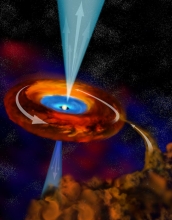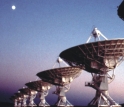|

Press Release 06-135
Massive Star Formation: Inside, Outside and All Around

Triple forces may allow giant stars to accumulate bulk
September 27, 2006
Scientists think they know how stars the size of our Sun are formed, but the theory breaks down for much larger stars. How do they accumulate masses up to 10 times or more than that of our own Sun? Now, new observations using the National Science Foundation's Very Large Array (VLA) radio telescope near Socorro, N.M., may help solve the mystery.
Maria Teresa Beltran, of the University of Barcelona in Spain, and astronomers from Italy and Hawaii, report their findings in the Sept. 28 issue of the journal Nature.
Stars form when gravity pulls giant intrastellar clouds of dust and gas inward, compacting the material into what becomes a star. But to make giant stars, astronomers propose the matter falling in instead forms a disk that whirls around the star. The whirling disk allows more matter in and also flings material outward.
"There should be material falling inward, rushing outward and rotating around the star all at the same time," Beltran said.
She and her team studied a young star called G24 A1, which is about 20 times more massive than the Sun, and that's exactly what they observed. It's the first time all three types of motion have been seen in a single, young massive star and makes a strong case for how very massive stars form.
Read NRAO's full release at http://www.nrao.edu/pr/2006/starflow
-NSF-

Media Contacts
Dave Finley, National Radio Astronomy Observatory (505) 835-7302 dfinley@nrao.edu
Josh Chamot, National Science Foundation (703) 292-7730 jchamot@nsf.gov

The National Science Foundation (NSF) is an independent federal agency that supports fundamental research and education across all fields of science and engineering. In fiscal year (FY) 2009, its budget is $9.5 billion, which includes $3.0 billion provided through the American Recovery and Reinvestment Act. NSF funds reach all 50 states through grants to over 1,900 universities and institutions. Each year, NSF receives about 44,400 competitive requests for funding, and makes over 11,500 new funding awards. NSF also awards over $400 million in professional and service contracts yearly.
 Get News Updates by Email Get News Updates by Email
Useful NSF Web Sites:
NSF Home Page: http://www.nsf.gov
NSF News: http://www.nsf.gov/news/
For the News Media: http://www.nsf.gov/news/newsroom.jsp
Science and Engineering Statistics: http://www.nsf.gov/statistics/
Awards Searches: http://www.nsf.gov/awardsearch/
| 


